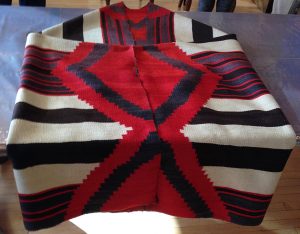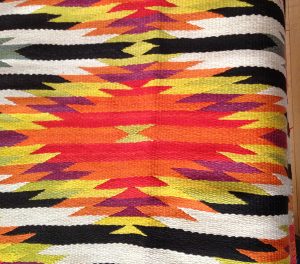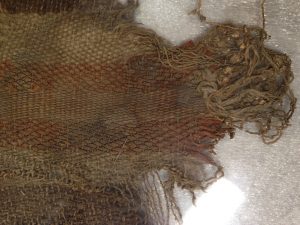
Navajo Chief Blanket – LBM Collection
The first Navajo textile we viewed during Mark and Linda Winter’s consultant visit to the Luther Bean Museum (LBM) was a late phase Chief blanket in very good condition. Mark folded the blanket to show how the pattern would appear when worn. I found it amazing that these patterns were designed in the mind of the weaver rather than drawn on paper.

Navajo Eye Dazzler – LBM Collection
Next we viewed a beautiful Eye Dazzler. Although the serrated designs were likely initially inspired by Mexican Saltillo blanket designs, the Navajo made serrated designs their own. For centuries, Navajo dye colors had been limited, in part because imported dyestuffs were expensive. But when commercial synthetic dyes became available in the latter part of the nineteenth century, Navajo blankets exploded with a myriad of bright colors. Eye Dazzler blankets were known for these brilliant colors in dazzling serrated designs.
We viewed three Navajo weavings from the early twentieth century, when the tourist and Eastern markets for Native-American and southwestern goods was well established, and dealers were influencing the designs of Navajo weavings for that commercial market. One of these was a beautiful Chinle Revival blanket.

Late Anasazi Textile Fragment – LBM Collection
The last of the Native-American pieces was a fragment of a late Anasazi textile. This is a rare specimen. Mark pointed out the skillful weaving of alternating weft colors in some bands of the fragment and the vegetal or mineral dye used to color the cotton yarns.
Mark gave us background information on the textiles, for example, explaining the phases into which Chief blankets are classified according to the design, wool, and dyes, in addition to estimates of date ranges and probable dyes used in the textiles.
